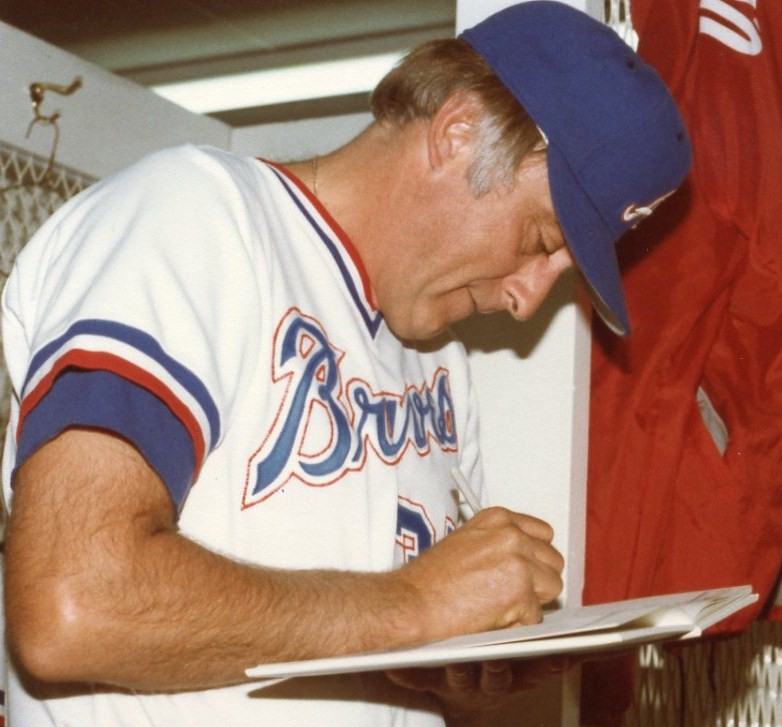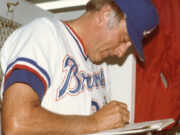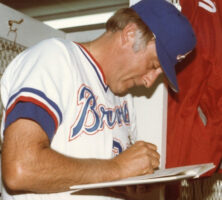Phil Niekro fashioned a long, successful sports career by mastering the most confounding pitch in the history of baseball—the knuckleball. During his twenty-one seasons with the Atlanta Braves, “Knucksie,” as he was known, became one of the most popular players in franchise history.

Photograph by Jim Accordino
Philip Henry Niekro was born on April 1, 1939, in Blaine, Ohio. His father, a coal miner and pitcher in the Mine Workers League, taught the knuckleball to both of his sons, Phil Jr. and Joe (who also joined the ranks of major league pitchers).
In 1959, after excelling in baseball and basketball in high school, Niekro turned down a college baseball scholarship to sign with the Milwaukee Braves. He slowly advanced through the minor league farm system as a relief pitcher until 1963, when he spent a year in the military.
On April 15, 1964, Niekro made his major league debut as a relief pitcher for the Milwaukee Braves. In 1966 he relocated with the team to Atlanta. The following year, after spending more time in the minor leagues perfecting his knuckleball, the 6-foot-1-inch, 180-pound right-hander became a starting pitcher for the Atlanta Braves. At the age of twenty-eight, he was a late bloomer on the mound. But he made up for lost time by pitching until he was forty-eight years old.
During his twenty-four-year career, which included stints with the New York Yankees (1984-85), Cleveland Indians (1986-87), and Toronto Blue Jays (1987), Niekro compiled a lifetime record of 318-274, with a 3.35 earned run average (ERA). He was the only pitcher in the major leagues to achieve 300-plus victories by relying almost exclusively on the knuckleball.
Unlike other pitches, the knuckleball floats with no spin or rotation, then suddenly dips, dives, or swoops. It’s almost impossible not only to hit but also for pitchers to control. Most knuckleball pitchers lose as many games as they win—Niekro was the exception (along with Hoyt Wilhem, who also pitched into his late forties). Despite its name, the knuckleball isn’t actually thrown with the knuckles. Niekro held the ball so that the first two fingers of his right hand—tips and nails only—touched the top of the ball.
Twice he led the National League in wins, and in 1969 he propelled Atlanta to the National League West title with a record of 23-13 (21 complete games and 2.56 ERA). On August 5, 1973, he pitched a no-hitter against the San Diego Padres. In 1982 Niekro assisted the Braves to another division title during a losing era in which Braves fans rarely found much to cheer about.
A five-time All-Star, Niekro notched 3,342 strikeouts in his career. With his younger brother he helped set a new record for wins (539) by brothers in the major leagues. In addition to pitching, Niekro was also known as a fine all-around player. Not only was he a five-time Gold Glove winner, but he possessed one of the best right-handed pickoff moves in the game.
As one of the most beloved Atlanta Braves players in franchise history, Niekro (number 35) joined only four other players (Warren Spahn, Eddie Mathews, Hank Aaron, and Dale Murphy) to have their numbers officially retired. Along with Aaron, “Knucksie” is honored with a statue at Truist Park. In 1997 Niekro was elected to the National Baseball Hall of Fame.
After retiring from baseball, Niekro managed Atlanta’s AAA farm club at Richmond in 1991. In 1994 he took over the managerial reins of the Colorado Silver Bullets women’s professional baseball team. Later he retired and moved with his family to Flowery Branch.
Phil Niekro died on December 26, 2020, at the age of eighty-one.





